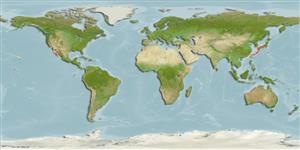分類 / Names
俗名 | 同種異名 | Catalog of Fishes(屬, 種) | ITIS | CoL | WoRMS | Cloffa
Teleostei >
Callionymiformes (Dragonets)
鱸形目 (Dragonets) >
Callionymidae (Dragonets)
科 (Dragonets)
Etymology: Synchiropus: Greek, syn, symphysis = grown together + Greek, cheir = hand + Greek, pous = foot (Ref. 45335).
Eponymy: Kiyoe Tanaka was the widow of Tatsuo Tanaka and donated land and facilities to help set up the Tatsuo Tanaka Memorial Biological Station on Miyake-jima, Japan. (Ref. 128868), visit book page.
More on authors: Fricke & Zaiser.
Environment: milieu / climate zone / 深度上下限 / distribution range
生態學
海洋 居於水底的; 深度上下限 5 - 14 m (Ref. 58018). 溫帶
Pacific Ocean: Japan. Photographed in Hawaii (Ref. 28618).
太平洋: 日本。 在夏威夷照相了。 (參考文獻 28618)
大小 / 重量 / 年齡
成熟度: Lm ? range ? - ? cm
Max length : 2.0 cm SL 雄魚/尚未辨別雌雄; (Ref. 559)
背棘 (總數) : 4; 背的軟條 (總數) : 9; 臀棘: 0; 臀鰭軟條: 8. Body moderately depressed. Preopercular spine long, without antrorse process at base and with 5 to 6 processes on inner side; posterior tip strongly upcurved. Lateral line on body conspicuously curved upward above the pectoral fin. Attains 2 cm SL.
Body shape (shape guide): fusiform / normal; Cross section: circular.
身體一般扁平的。 前鰓蓋骨棘長的, 沒有向前及向上的突起在基底而且在內部的側邊上 5 到 6個突起; 後頂端強烈向上彎曲。 在身體上的側線顯著地彎曲了向上的上方胸鰭。 達到 2 公分 SL 。
Occurs in bottoms with coarse sand, broken shell, volcanic gravel, and small rocks with dead algae.
用粗糙的沙子,碎貝又火山的礫石與小的岩石以死的藻類出現於底部。
Life cycle and mating behavior
成熟度 | 繁殖 | 產卵場 | 卵 | 孕卵數 | 仔魚
太平洋: 日本。 在夏威夷照相了。 (參考文獻 28618)
Masuda, H., K. Amaoka, C. Araga, T. Uyeno and T. Yoshino, 1984. The fishes of the Japanese Archipelago. Vol. 1. Tokai University Press, Tokyo, Japan. 437 p. (text). (Ref. 559)
IUCN 瀕危狀態 (Ref. 130435: Version 2025-1)
無危 (LC) ; Date assessed: 24 March 2022
人類使用
工具
特別的報告
下載 XML
網路資源
Estimates based on models
Preferred temperature (參考文獻
123201): 20.5 - 27.4, mean 25.1 °C (based on 215 cells).
Phylogenetic diversity index (參考文獻
82804): PD
50 = 0.5000 [Uniqueness, from 0.5 = low to 2.0 = high].
Bayesian length-weight: a=0.00955 (0.00394 - 0.02313), b=2.96 (2.75 - 3.17), in cm total length, based on LWR estimates for this (Sub)family-body shape (Ref.
93245).
營養階層 (參考文獻
69278): 3.1 ±0.3 se; based on size and trophs of closest relatives
回復力 (參考文獻
120179): 高度, 族群倍增時間少於 15個月 (Preliminary K or Fecundity.).
Fishing Vulnerability (Ref.
59153): Low vulnerability (10 of 100).
🛈
